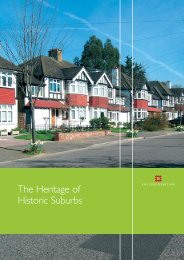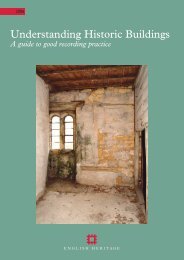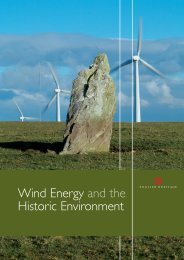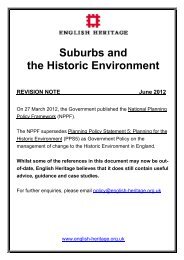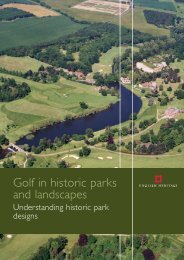Geophysical Survey in Archaeological Field Evaluation - HELM
Geophysical Survey in Archaeological Field Evaluation - HELM
Geophysical Survey in Archaeological Field Evaluation - HELM
Create successful ePaper yourself
Turn your PDF publications into a flip-book with our unique Google optimized e-Paper software.
14<br />
Page numbers <strong>in</strong> the right hand column refer<br />
to pages elsewhere <strong>in</strong> the document where<br />
more detailed discussion is available: readers<br />
are cautioned not to accept a survey option<br />
without consult<strong>in</strong>g the relevant sections of<br />
Part IV. The same advice applies to Table 3,<br />
which lists some of the most commonly<br />
occurr<strong>in</strong>g types of archaeological feature, and,<br />
alongside each, attempts to categorise the<br />
suitability of the ma<strong>in</strong> survey techniques for<br />
its detection <strong>in</strong> each case. Table 4 lists very<br />
generalised comments on the suitability of the<br />
major solid and drift geologies to magnetometer<br />
survey only (the responses of other geophysical<br />
techniques to differ<strong>in</strong>g geologies are less easy<br />
to categorise simply; where possible reference<br />
to these responses is made <strong>in</strong>dependently <strong>in</strong><br />
Part IV).<br />
In submitt<strong>in</strong>g these tables we must acknowledge<br />
that they are a considerable over-simplification<br />
and therefore reiterate that they are <strong>in</strong>tended<br />
to serve only as a rough guide to choice of<br />
survey technique. Professional op<strong>in</strong>ion varies<br />
on some of the attributions offered. For the<br />
moment, and <strong>in</strong>to the foreseeable future, each<br />
situation will warrant specialist advice and this<br />
should be sought at an early stage <strong>in</strong> any project,<br />
once the general necessity for geophysical<br />
survey has been established.<br />
The tables are followed by a more specific<br />
discussion of the survey options for a selection<br />
of commonly occurr<strong>in</strong>g evaluation scenarios.<br />
For those who wish to follow up aspects of<br />
technique and methodology <strong>in</strong> more detail we<br />
recommend consult<strong>in</strong>g Part IV. Furthermore,<br />
valuable complementary <strong>in</strong>formation is available<br />
<strong>in</strong> the follow<strong>in</strong>g publications: Clark (1996);<br />
Gaffney and Gater (1993; 2003); Gaffney,<br />
Gater and Ovenden (2002); L<strong>in</strong>ford (2006).<br />
3 Costs<br />
Rout<strong>in</strong>e archaeological surveys are usually<br />
costed per hectare of area covered at standard<br />
sampl<strong>in</strong>g <strong>in</strong>tervals. Such prices are usually<br />
<strong>in</strong>clusive of all aspects of the work and the<br />
supply of a report (and a specified number<br />
of copies of this). However, <strong>in</strong> some cases –<br />
particularly geotechnical surveys – quotations<br />
may not be all-<strong>in</strong>clusive and fieldwork may<br />
be costed per day on site with separate<br />
charges for data analysis and report<strong>in</strong>g. There<br />
may be a reduction if multiple techniques are<br />
carried out on a shared grid and concessions<br />
may be available if there is a research and/or<br />
publicity <strong>in</strong>terest for the company concerned.<br />
Prices can vary significantly between different<br />
companies and will of course vary accord<strong>in</strong>g<br />
to constra<strong>in</strong>ts peculiar to each site. Clients<br />
are advised to obta<strong>in</strong> a range of quotations<br />
for scrut<strong>in</strong>y. Care should be taken to<br />
establish whether or not VAT is <strong>in</strong>cluded.<br />
On completion of the tender<strong>in</strong>g process it is<br />
good procurement practice for the client to<br />
name the successful contractor, to declare the<br />
range of prices received and to provide a list<br />
of tender applicants.<br />
4 Urban (and brownfield) sites<br />
The depth and complexity of most urban<br />
stratigraphy, closely constra<strong>in</strong>ed by modern<br />
<strong>in</strong>trusions, metallic contam<strong>in</strong>ation, services and<br />
adjacent structures, provides a near <strong>in</strong>superable<br />
Table 3 Match<strong>in</strong>g survey method to feature type: survey options (see key below): the choice<br />
of geophysical survey method(s) appropriate to a range of archaeological features, based on<br />
experience from the UK. Only the most commonly used survey methods are listed. This is a<br />
rough guide only, to which there will be exceptions, depend<strong>in</strong>g upon <strong>in</strong>dividual site circumstances<br />
and future technical developments.<br />
Feature type Mag area Earth res GPR EM Mag susc<br />
survey survey (cond)<br />
areas of occupation Y n N ? y<br />
below artefact scatters Y Y N ? y<br />
large pits (>2m diam) Y y Y ? N<br />
smaller pits (0.5m diam) y n y N N<br />
hearths Y N N n ?<br />
kilns/furnaces Y N ? ? ?<br />
sunken-featured build<strong>in</strong>gs Y y ? ? N<br />
house platforms ? y n ? ?<br />
ditches (2m width) Y y ? ? n<br />
palaeochannels y y Y y n<br />
roads/tracks y y ? ? n<br />
robber/bedd<strong>in</strong>g trenches y Y ? N N<br />
timber structures y n ? N N<br />
masonry foundations ? Y Y Y N<br />
brick foundations y Y Y ? N<br />
pav<strong>in</strong>g/floors – Y Y ? N<br />
buried megaliths (mag) Y Y Y ? N<br />
buried megaliths (non-mag) – Y Y ? N<br />
stone-l<strong>in</strong>ed dra<strong>in</strong>s n y Y ? N<br />
other cavities n Y Y ? N<br />
graves ? y ? N N<br />
cremations n N N N ?<br />
ridge and furrow Y Y N n n<br />
lynchets y Y N n n<br />
waterlogged contexts ? ? ? ? ?<br />
key:<br />
Y The technique responds well <strong>in</strong> many conditions and is usually to be recommended.<br />
y The technique can respond effectively <strong>in</strong> many conditions but is best used <strong>in</strong> conjunction<br />
with other techniques.<br />
? The technique may work well <strong>in</strong> some conditions, and its use may therefore be<br />
questionable; another technique might be preferable.<br />
n The technique may work <strong>in</strong> some conditions but is not usually recommended; another<br />
technique is usually preferable.<br />
N The technique is probably not effective, or its effectiveness is uncerta<strong>in</strong>.






